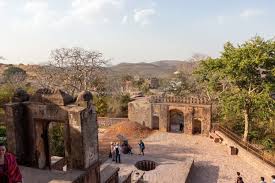Kuchaman Haveli
Kuchaman Haveli in Jodhpur is a historic haveli (traditional mansion) that has been converted into a heritage hotel. Located in the heart of the old city, near the iconic Mehrangarh Fort and other notable attractions, it offers a glimpse into the opulent lifestyle of the Marwari merchants of Rajasthan.
Historical Background
Built by: Kuchaman Haveli was originally built in the early 19th century by a wealthy Marwari merchant family from the town of Kuchaman in Rajasthan. The Marwaris were known for their business acumen and played a significant role in trade and commerce across India.
Architectural Style: The haveli is a fine example of traditional Rajasthani architecture, featuring intricately carved facades, jharokhas (overhanging enclosed balconies), and elaborate frescoes. The structure reflects the blend of Mughal and Rajput styles, which is typical of the region’s heritage buildings.
Features of Kuchaman Haveli
Courtyards and Rooms: The haveli is designed around multiple courtyards, which provide ventilation and light to the interiors. The rooms are adorned with period furniture, ornate mirrors, and traditional Rajasthani artwork, offering an authentic experience of living in a historic mansion.
Frescoes and Paintings: One of the distinctive features of Kuchaman Haveli is its vibrant frescoes and wall paintings, which depict scenes from Rajasthani culture, mythology, and daily life. These artworks are a testament to the artistic skills of the craftsmen of that era.
Terrace and Views: The haveli’s rooftop terrace offers panoramic views of the Mehrangarh Fort and the blue houses of Jodhpur. It is a popular spot for guests to relax and enjoy the sunset over the city.
Cultural and Historical Significance
Connection to Kuchaman: The haveli is named after the town of Kuchaman, which is known for its own fort and havelis. The connection between the merchant families of Kuchaman and Jodhpur highlights the network of trade and cultural exchange that existed in Rajasthan during the 18th and 19th centuries.
Heritage Conservation: By being converted into a heritage hotel, Kuchaman Haveli serves as a significant example of how historic buildings can be preserved and repurposed. This not only conserves the architectural legacy but also allows visitors to experience the rich history and culture of the region firsthand.
Tourism: Today, Kuchaman Haveli is a popular destination for tourists seeking an immersive cultural experience in Jodhpur. The haveli’s location in the old city makes it an ideal base for exploring the nearby attractions, including the Mehrangarh Fort, Jaswant Thada, and the bustling Sardar Market.













